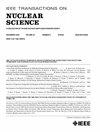High-Resolution Cr/4H-SiC Schottky Barrier Radiation Detector
IF 1.9
3区 工程技术
Q3 ENGINEERING, ELECTRICAL & ELECTRONIC
引用次数: 0
Abstract
In this article, we present the first comprehensive analysis of radiation detection using chromium (Cr) as the Schottky barrier contact on n-type 4H-silicon carbide (4H-SiC) epitaxial layers tailored for high-performance applications in extreme environments. The Cr/4H-SiC Schottky barrier diode (SBD) is evaluated across several critical metrics, including junction properties, radiation response, and defect characteristics, and is compared with SBDs utilizing other refractory metals such as molybdenum (Mo), palladium (Pd), and nickel (Ni) on analogous 4H-SiC epilayers. Despite the lower work function of Cr, 4.5 eV, compared to the other metals, the Cr/4H-SiC SBDs demonstrated exceptional rectification behavior, achieving a barrier height of 1.13 eV and a low leakage current of 6.7 nA at −100 V reverse bias. These characteristics are ideal for high-resolution radiation detection applications. The Cr/4H-SiC SBD exhibited an impressive energy resolution of 0.5% at an optimized bias of −40 V when exposed to 5486-keV alpha particles. Notably, in self-biased mode (0 V applied bias), the device delivered an energy resolution of 2.3% and a charge collection efficiency (CCE) of 73%, surpassing the performance of benchmark Ni/4H-SiC SBDs. Capacitance-mode deep-level transient spectroscopy (DLTS) analysis revealed the presence of key deep-level defects, including Z高分辨率Cr/4H-SiC肖特基屏障辐射探测器
在本文中,我们首次全面分析了在极端环境下高性能应用的n型4h碳化硅外延层上使用铬(Cr)作为肖特基势垒接触的辐射检测。通过几个关键指标对Cr/4H-SiC肖特基势垒二极管(SBD)进行了评估,包括结特性、辐射响应和缺陷特征,并与在类似的4H-SiC涂层上使用其他难熔金属(如钼(Mo)、钯(Pd)和镍(Ni))的SBD进行了比较。尽管Cr的功函数较低,为4.5 eV,但与其他金属相比,Cr/4H-SiC sdd表现出优异的整流行为,在- 100 V反向偏置下实现了1.13 eV的势垒高度和6.7 nA的低漏电流。这些特性是高分辨率辐射探测应用的理想选择。当暴露于5486 kev α粒子时,Cr/4H-SiC SBD在- 40 V的优化偏置下表现出令人印象深刻的0.5%的能量分辨率。值得注意的是,在自偏置模式(0 V施加偏置)下,该器件提供了2.3%的能量分辨率和73%的电荷收集效率(CCE),超过了基准Ni/4H-SiC sbd的性能。电容模式深能级瞬态光谱(DLTS)分析显示,材料中存在Z ${}_{1/2}$和EH5陷阱中心等关键深能级缺陷以及钛替代缺陷。其中,被广泛认为是寿命杀手的Z ${}_{1/2}$陷阱中心对探测器的性能起着重要的影响。本文的研究结果强调了Cr/4H-SiC固态硬盘在恶劣环境(如核反应堆和太空探索任务)中高效、自偏置辐射探测的潜力。
本文章由计算机程序翻译,如有差异,请以英文原文为准。
求助全文
约1分钟内获得全文
求助全文
来源期刊

IEEE Transactions on Nuclear Science
工程技术-工程:电子与电气
CiteScore
3.70
自引率
27.80%
发文量
314
审稿时长
6.2 months
期刊介绍:
The IEEE Transactions on Nuclear Science is a publication of the IEEE Nuclear and Plasma Sciences Society. It is viewed as the primary source of technical information in many of the areas it covers. As judged by JCR impact factor, TNS consistently ranks in the top five journals in the category of Nuclear Science & Technology. It has one of the higher immediacy indices, indicating that the information it publishes is viewed as timely, and has a relatively long citation half-life, indicating that the published information also is viewed as valuable for a number of years.
The IEEE Transactions on Nuclear Science is published bimonthly. Its scope includes all aspects of the theory and application of nuclear science and engineering. It focuses on instrumentation for the detection and measurement of ionizing radiation; particle accelerators and their controls; nuclear medicine and its application; effects of radiation on materials, components, and systems; reactor instrumentation and controls; and measurement of radiation in space.
 求助内容:
求助内容: 应助结果提醒方式:
应助结果提醒方式:


